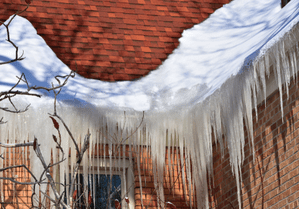Winter is a particularly challenging month for homeowners. In addition to shoveling their driveways and salting their sidewalks, they need to prevent ice dams and icicles from forming on their rooftops.
While they may look picturesque, icicles and ice dams can be quite dangerous. Ice dams can weigh up to hundreds of pounds, and water/ice damage makes up 20 percent of all homeowner insurance claims. Here are some effective ways to detect, remove and prevent ice dams.
What is an Ice Dam?
During the cold winter months, the icicles on a house’s eaves may signify that a ridge of ice is forming at the edge of the roof. This ridge, known as an ice dam, can prevent melting snow from draining properly.
Ice dams are caused by uneven heat loss from a home in wintry conditions re-freezing melted snow. This causes the roof to warm above freezing temperature, which allows snow to melt and then re-freeze before it reaches the roof’s edge. If this cycle repeats consistently, an ice dam will form, and water will collect behind it. As the water pools, it accumulates and can lead to expensive water damage, seeping under shingles and into the house.
Ice Dam Indications:
- Stained ceilings and walls near the ice dam.
- Dripping water or stained rafters and insulation in your attic.
- Ice formed around the base of your chimney where it meets your roof
- Dislodged shingles and drooping gutters.
Tips to Prevent Ice Dams:
- Keep the attic well ventilated. According to the Department of Energy, one square foot of free ventilation opening is recommended for every 150 square feet of attic space.
- Seal air leaks to prevent warm air leakage from plumbing vents, junction boxes from ceiling fixtures, and attic hatches.
- Keep the attic floor well insulated (between 16 and 22 inches of insulation) to minimize the amount of heat rising into the attic from below.
- Clean leaves and other debris from gutters before the first snow. This will help prevent ice buildup in your gutters.
- Assess your roof. It is important to get your roof inspected regularly and detect and fix potential problem areas (particularly after a storm). You should also assess your roof’s slope – if constructed properly, a sloped roof can shed heavy snow, ice, or melting water. In general, the gentler the slope, the more at risk you are for a roof collapse.
- Consider using an ice shield under your shingles when your house is re-roofed.
- Use a roof rake to clear the snow above the gutter. Clear as much as three to four feet above the gutter to allow water to drain freely into the gutter. This way, once the ice melts, water will have a means of egress from the roof, eliminating the risk of standing water and major damage.
- Consider hiring an energy specialist to evaluate the performance of your home and recommend some things you can do to minimize energy waste.
- Additionally, hire a licensed and insured professional to prevent ice dams from occurring. A professional can help with one or more of the following tasks:
- Use high-pressure steam or other specialized treatments to remove ice.
- Install electric heating cables on your roof, which will allow ice to melt and safely drain.
- Add additional attic insulation, if needed.
- Inspect your roof and make any repairs.
- Maintain your roof throughout the year. Proper maintenance is crucial when it comes to preventing ice dams. Specifically, you should ensure that any roof drainage systems, such as scuppers, gutters, and downspouts, are free of debris and working properly. Be sure to also cut back overhanging trees or vegetation, as falling debris can clog your drainage systems.
- Consider re-roofing. You can install a secondary moisture barrier to help prevent heat loss during the installation process. For best results, moisture barriers should be placed in roof valleys, where snow and ice are likely to collect during the winter.
What Do You Do If an Ice Dam Has Already Formed?
If an ice dam forms on your roof, sprinkle a melting compound to break it up. Avoid using traditional rock salt, as it may cause further damage and faster deterioration of your gutters.
If an ice dam has formed on your gutters, do not chip away at already-formed dams, as this can cause more damage.
Need Extra Assistance Protecting Your Home?
Set up a consultation with one of Horton’s personal insurance experts to reduce your stress and save money by preparing accordingly. We hope these tips protect your house from the rough winters ahead.
Material posted on this website is for informational purposes only and does not constitute a legal opinion or medical advice. Contact your legal representative or medical professional for information specific to your legal or medical needs.




